What is behind North Korea’s new hard-line stance?
A North Korean government official insider has revealed what is behind the regime’s new hard-line stance towards the South.
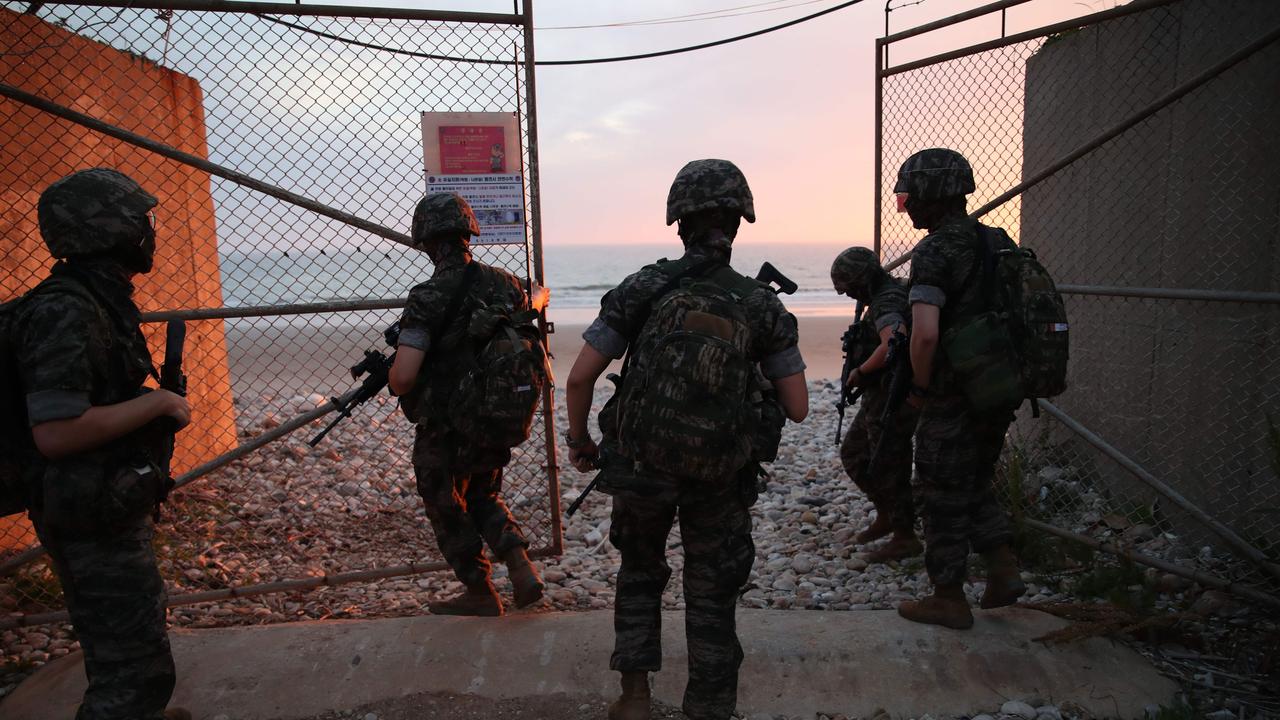
North Korea’s symbolic destruction of an inter-Korean liaison office on Tuesday is part of efforts by Kim Jong-un’s sister to boost her “revolutionary” credentials, regime insiders have reportedly claimed.
The South Korea-based Daily NK, a well regarded outlet which maintains a network of informants inside the Communist dictatorship, quotes a “high-level government official” who explains Kim Yo-jong’s new hard-line stance towards the South.
“She can't rule the country from the military like her brother, so she is expanding her authority through the Propaganda and Agitation Department, just like her father (Kim Jong-il),” the source was quoted telling the outlet.
Kim Jong-un attended Kim Il-sung Military University and was named a “general of the Korean People's Army” in 2010.
After his father’s death the following year he solidified his status by commanding a military unit.
With no military background, his sister has to gain political power in other ways – moves to expand her “revolutionary achievements”, vocally supported by her brother, have accelerated since his mysterious health problems in April.
Daily NK reports that Kim Jong-un himself felt the need to prepare for his sister potentially taking the reins, however “several high-level officials” told the outlet that the goal is not to set her up as a successor.
Rather, she is expected to stabilise the country’s affairs until his 12-year-old son can take over.
“In their eyes, Kim is playing the traditional role of an ‘empress dowager’ who takes control of state affairs until a younger prince comes of age,” Daily NK reports.
Until recently, Kim Yo-jong has been more closely associated with the North’s diplomatic efforts, but in recent weeks has been leading calls to retaliate against South Korea’s failure to prevent activists from floating propaganda leaflets across the border.
Outside analysts say her portrayal in state media as the voice of Pyongyang’s anger over the activists – and now a role in a highly visible action – could be intended to bolster her credibility with the North Korean military and other hawks.
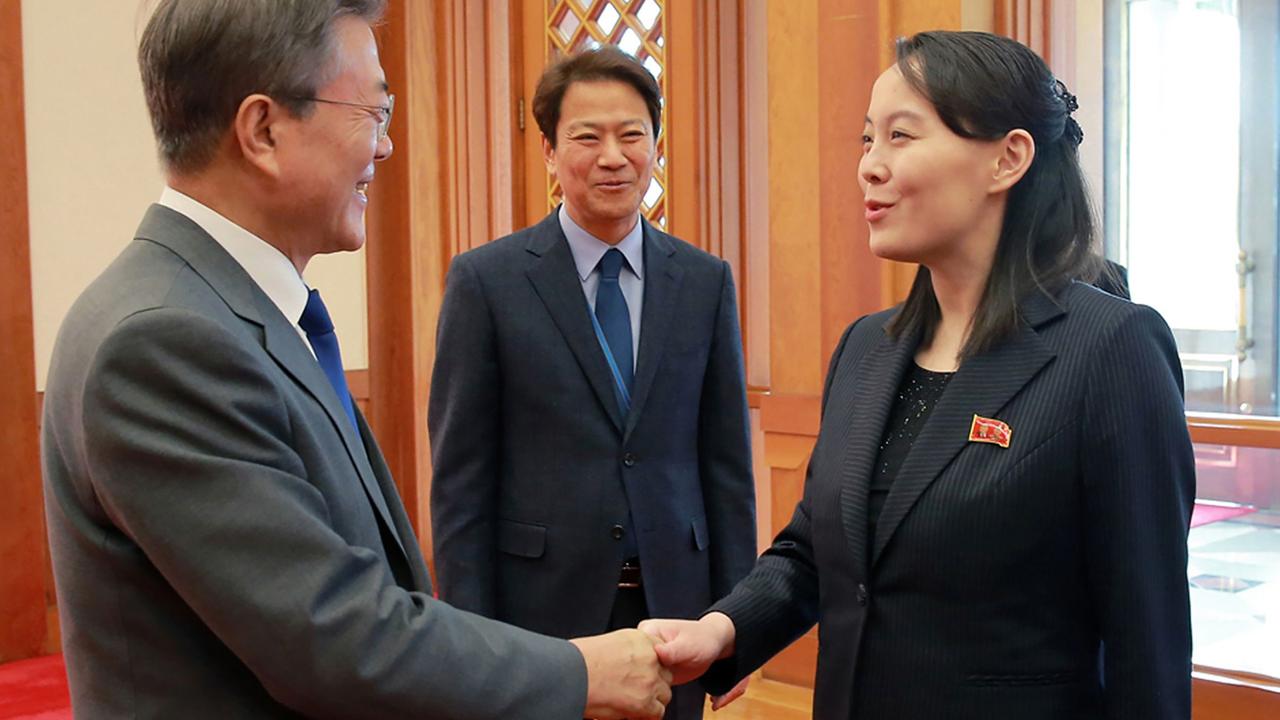
On Saturday, she warned the liaison office would soon be seen “completely collapsed”.
“I feel it is high time to surely break with the South Korean authorities,” she said, adding she had instructed the military and would soon “take action”. “Rubbish must be thrown into the dustbin,” she said.
George Mason University Korea Professor Andray Abrahamian told the BBC that many of North Korea’s outward-facing choices “are to do with internal politics and we can never be sure exactly what's going on”.
“There's been some speculation in the past week that North Korea wants to extract some concessions from the South, wants to get the United States' attention without testing a long-range missile, or perhaps wants to create a crisis as a prelude to justifying emergency talks,” he said.
“None of these strategic explanations is entirely satisfying.”
Van Jackson, author of On the Brink: Trump, Kim, and the Threat of Nuclear War, told the broadcaster Kim Jong-un felt betrayed by US President Donald Trump, having expected relief from punishing economic sanctions following their failed summits but receiving none.
“The reason for targeting South Korea is strategic – North Korea risks conflict escalation if it attacks the United States directly, so has taken aim at the South as a perceived vulnerable target less likely to trigger a war,” he said.
Combined with the unknown internal impact of COVID-19 – officially North Korea has had no cases – and the pandemic causing reduced trade with its main ally China, the effect of continued sanctions on its economy has been devastating.
Daily NK reported earlier this week that the regime has not been able to supply rations to residents in the capital Pyongyang since March, raising fears of a repeat of the 1990s famine estimated to have killed millions of people.
“The situation is so dire that there is even talk of a ‘second Arduous March’ among Pyongyangites,” a source told the outlet.
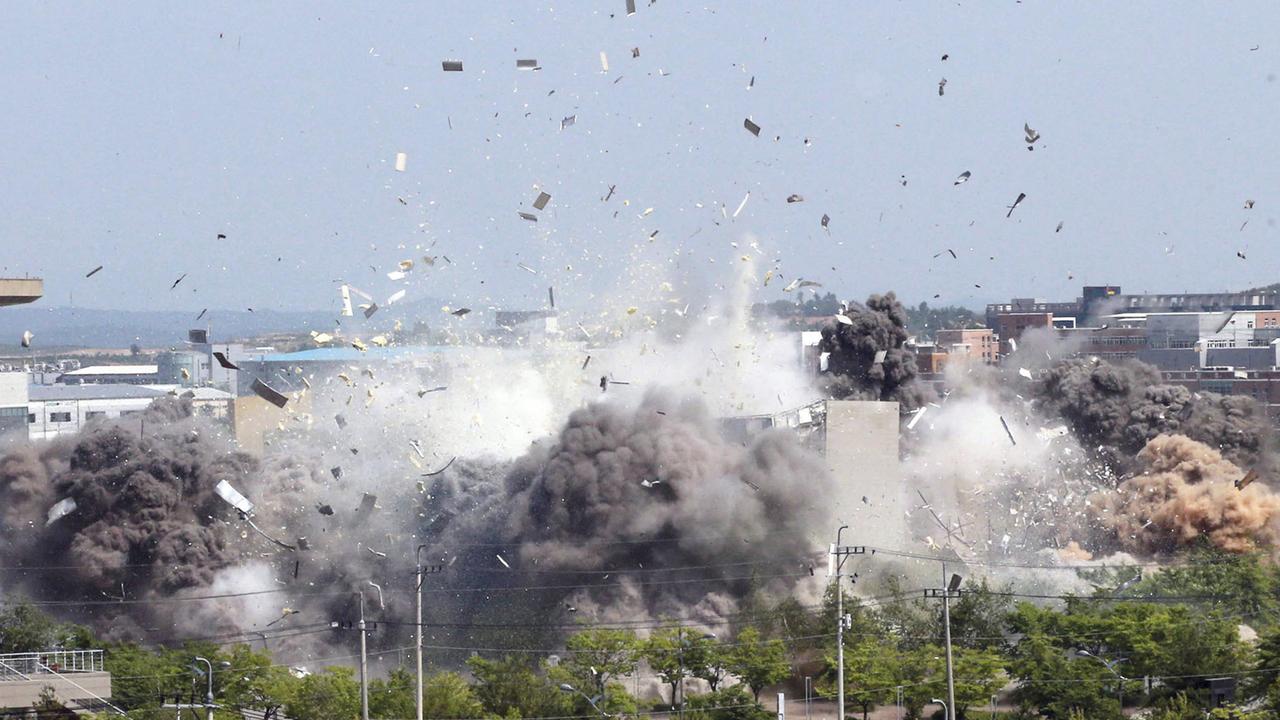
‘PUNISH HUMAN SCUM’
On Wednesday, North Korea said it would redeploy troops to now-shuttered inter-Korean tourism and economic sites near the border with South Korea and take other steps to nullify landmark 2018 tension-reduction deals.
Tuesday’s carefully choreographed, largely symbolic display of anger in blowing up the inter-Korean liaison office puts pressure on Washington and Seoul amid deadlocked nuclear diplomacy.
The demolition was the most provocative act by North Korea since it entered nuclear talks in 2018, though the building was empty and the North had previously signalled plans to destroy it.
The North’s General Staff said units of the regiment level and necessary firepower sub-units will be deployed at the sites of the Diamond tourism project and the Kaesong industrial complex, both located just north of the heavily-fortified border.
Those sites, once symbols of inter-Korean co-operation, have been shuttered for years amid animosities over North Korea’s nuclear program.
The North said it will also resume military exercises and re-establish guard posts in border areas and open frontline sites for flying propaganda balloons toward South Korea.
These steps mean that North Korea will nullify a 2018 deal with South Korea aimed at lowering military tensions at border areas.
Under those agreements, the two Koreas halted live-firing exercises, removed some landmines and destroyed guard posts inside their border, the world’s most heavily fortified.
Some outside experts said such steps have undermined South Korea’s national security more as the North’s nuclear weapons arsenal remains intact.
South Korea’s government didn't have immediate response to the North Korean military statement.
Seoul's Defense Ministry said on Tuesday it would strongly deal with future provocation by North Korea.
The North’s official Korean Central News Agency on Wednesday repeated its hard-line stance against South Korea has been taken to retaliate South Korea’s failure to prevent activists from floating propaganda leaflets across the border.
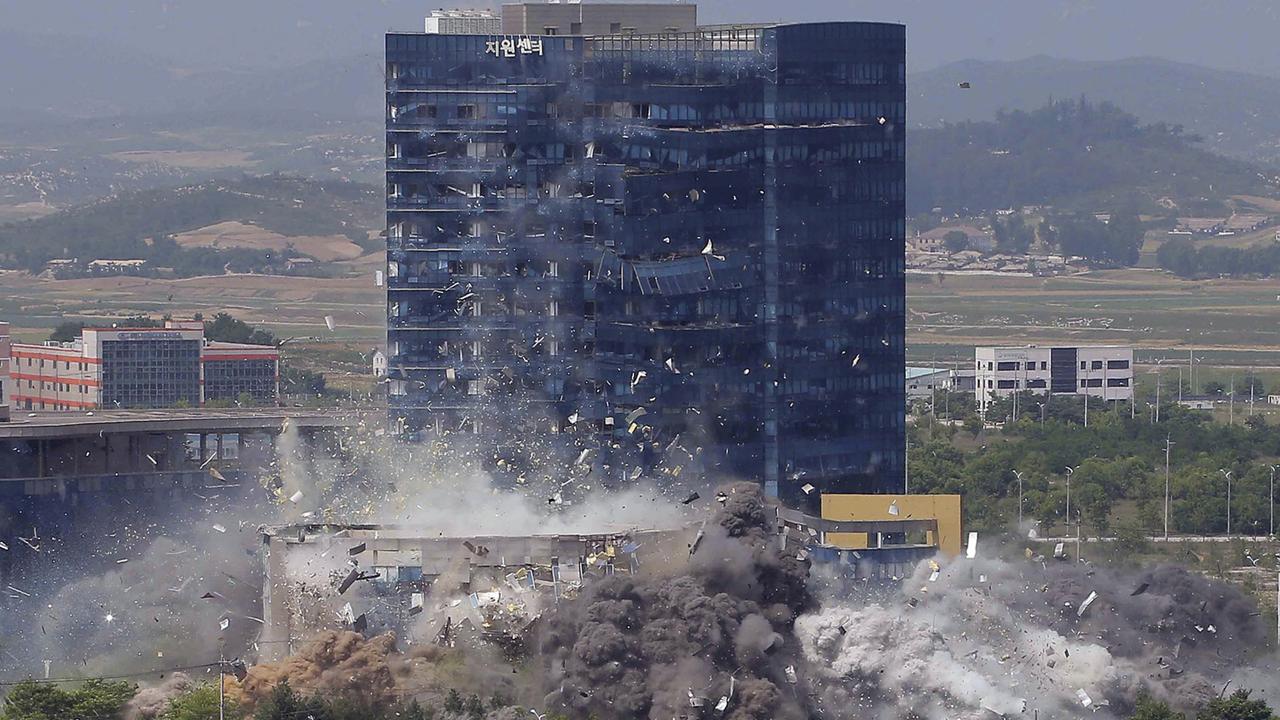
The building destruction was a “reflection of the zeal of our enraged people to punish human scum who challenged the noblest dignity and prestige of our country and those who sheltered the scum, perpetrators of shuddering crime”.
It said the destruction is the first step of the North’s retaliatory action against South Korea and the North will set the intensity and timing for its additional steps while closely monitoring South Korean moves.
“Under such an acute situation as now, shameless and reckless attitude and response of the South Korean authorities will lead to our tougher retaliation plans,” it said.
Kim Yo-jong issued a separate statement saying North Korea had rebuffed a recent offer by South Korean President Moon Jae-in to send special envoys to Pyongyang to defuse animosities.
She said Mr Moon had offered to dispatch his National Security Director Chung Eui-yong and spy chief Suh Hun at the earliest possible date that North Korea would want.
Kim Yo-jong has spearheaded the North’s recent fiery rhetoric against South Korea, called Mr Moon’s offer “unrealistic” and “nonsensical” and said South Korea must pay the price for its failure to stop activists from sending anti-Pyongyang leaflets toward North Korea.
On Tuesday, the North destroyed with explosives the liaison office building the border town of Kaesong, the first such inter-Korean office which the two Koreas opened in 2018 when their ties flourished.
North Korea’s official Korean Central News Agency said the country destroyed the office in a “terrific explosion”.
South Korea issued a statement expressing “strong regret” over the destruction of the building, warning of a stern response if North Korea takes additional steps that aggravate tensions.
It was a serious setback to the efforts of Mr Moon to engage the North. Mr Moon, a liberal who champions greater reconciliation with North Korea, shuttled between Pyongyang and Washington to help set up the first summit between Kim Jong-un and President Donald Trump in June 2018.
Inter-Korean relations have been strained since the breakdown of a second summit between Kim Jong-un and Mr Trump in Vietnam in early 2019.
The summit fell apart because of disputes over how much sanctions relief the North should get in return for Kim Jong-un’s dismantling of his main nuclear complex, which was seen as a limited denuclearisation measure.
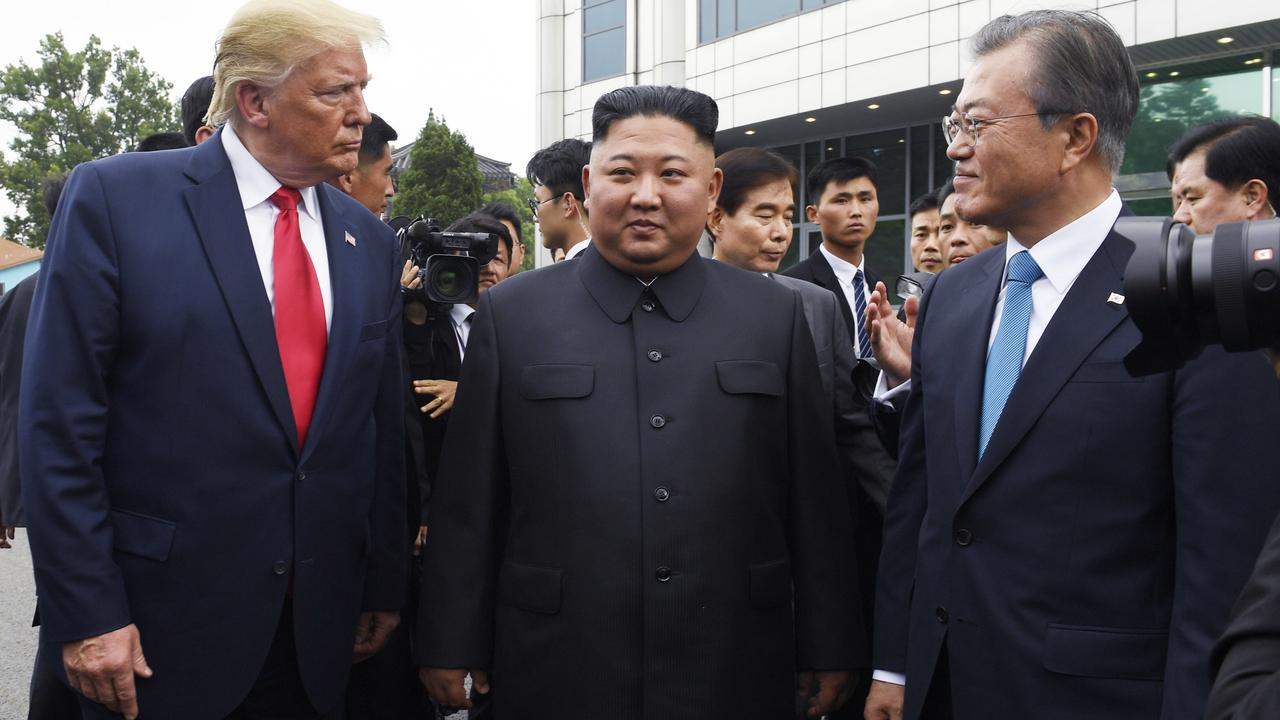
SEVEN-HOUR SPEECH
In his New Year’s address – said to have been seven hours long – Kim Jong-un flagged a “fundamental strategic policy reorientation, ‘soup to nuts’”, North Korea expert Robert Carlin from the Henry L. Stimson Center's 38 North think tank explained earlier this year in a briefing analysing the speech.
“This is not a bluff. This is not a tactical move at the United States or at President Trump. There is no deal with the US to be had. That’s what Kim told his people,” Mr Carlin said.
“The main points, elaborating that, were as follows – the dialogue with the US is over because it achieves nothing and leaves the country vulnerable.
“There is, and there’s going to be, a long stalemate with the US. And the way to change this situation is not to sacrifice security through compromise and not to sacrifice what he identified as ‘the dignity of the country’. Instead, it is to change the objective reality.”
In his speech, Kim Jong-un stressed that “we should not look for the way of getting ourselves ‘adapted’ to the objective elements, to be controlled by them in the current struggle, but should make a frontal breakthrough to put the objective elements under our country”.
According to Mr Carlin, that means “developing a stronger and more threatening nuclear force”, while simultaneously attempting to strengthen the economy and prepare for a response from the international community.
“And I'm pretty sure Kim understands that means China and Russia," Mr Carlin said.
“The response is probably going to be to tighten and extend sanctions, and so to cope with that the people and the economy have to be prepared to do more with less. What does that mean? That means ‘belt tightening’, and he used that term explicitly and people in North Korea know exactly what that means, because they’ve been through it.”



